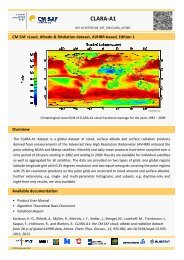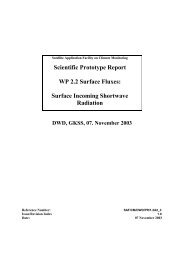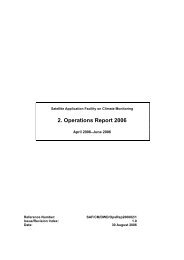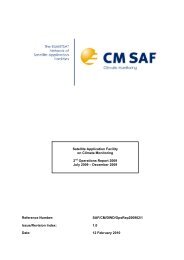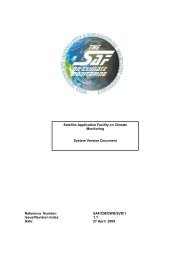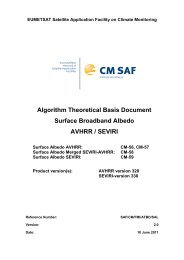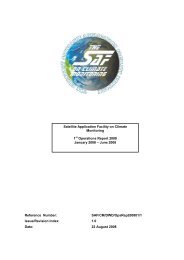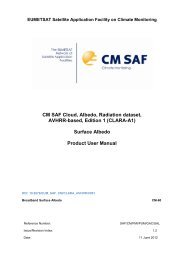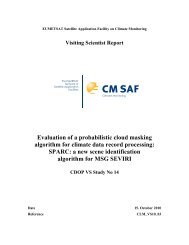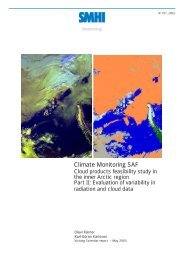Aerosol retrievals from METEOSAT-8 - CM SAF
Aerosol retrievals from METEOSAT-8 - CM SAF
Aerosol retrievals from METEOSAT-8 - CM SAF
You also want an ePaper? Increase the reach of your titles
YUMPU automatically turns print PDFs into web optimized ePapers that Google loves.
<strong>SAF</strong> on Climate Monitoring Visiting Scientists Report Doc. No: 1.0<br />
Issue : 1.0<br />
Date : 4 October 2006<br />
calculations. This assumption is mainly true when neglecting interaction between surface and<br />
molecules and for viewing geometries far <strong>from</strong> the “hot spot” of the vegetation (Knapp et al.,<br />
2002). The errors due to this assumption will be much lower for geostationary satellites because the<br />
bulk of observations are geometrically far <strong>from</strong> the “hot spot” (Knapp et al., 2005). The reference<br />
map of surface reflectance is generated for each observation time by applying above described<br />
method to all the image pixels. Finally, Fig. 7 summarises in a diagram the method to retrieve the<br />
reference surface reflectance map.<br />
Fig. 8 shows for every hour the reference surface reflectance map for the period 1-14 th July. The<br />
reference area covers almost all the continental areas. Noise appears for low solar elevations in the<br />
morning. This can be due to the cloud masking method, which is not robust for such sun-satellite<br />
geometries. Around 13:00 UTC some high reflectances appear in middle-Europe but there are large<br />
doubts about the accuracy of cloud detection in this area (lots of partly cloudy situations and<br />
scattered clouds).<br />
Fig. 9 gives the time series of the reference maps of surface reflectance for several locations: the<br />
Flandres in Belgium, the Landes forest in South-West of France, the Andalusia in the South of<br />
Spain and the north of Algeria. Temporal variation of the surface reflectance seems reasonable with<br />
regards to vegetation reflectance and biomass models used in MERIS Look-up-tables, i.e., variation<br />
of the surface reflectance with the scattering angle is similar to that used in MERIS LUT. The<br />
erroneous values of the surface reflectance for the Flandres area early in the morning is due to<br />
clouds, which are not detected by our cloud mask. Independently of such erroneous values, the<br />
curves are affected by a noise of small amplitude. The retrieval of ground reflectances is altered by<br />
differences in the residual aerosol loading within the composite period and differences in the<br />
observation date that corresponded to the minimum surface reflectance at the observation time. In<br />
the near future, one can find a solution to minimize the noise that is based on the following facts:<br />
• The surface BRDF varies smoothly with the solar angles along the day. One is allowed to apply<br />
a fit to the surface BRDF versus time.<br />
• A high reflectance value once or two times during the day indicates either a thin cloud or high<br />
aerosol load that was not detected by cloud masking or because no cloud free observations<br />
occurred during the composite time period at that particular time and locations. Those points<br />
should be discarded. In the data sample we used for this study, less than 0.01 % of the pixels<br />
were detected cloudy during the entire 14 days period.<br />
- 19 -



